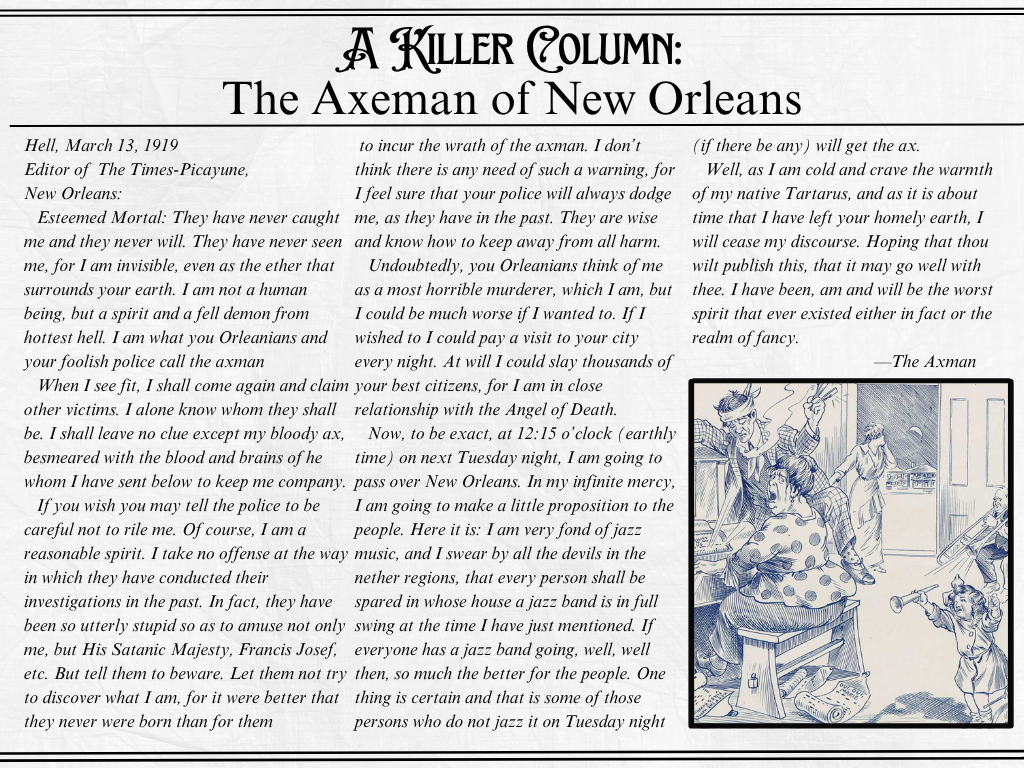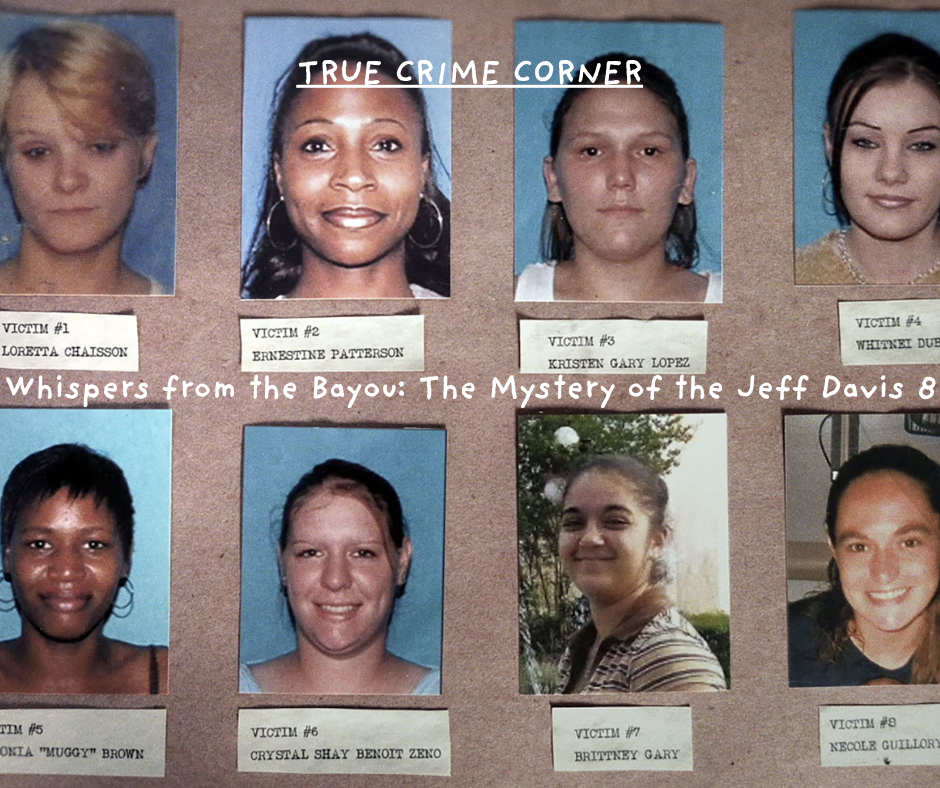Louisiana has a complex and deeply rooted history with crime, justice and systemic inequality. In each installment, I strive to approach these cases with care, respect and a commitment to truth—whether the story involves a decades-old cold case, a recent courtroom development or a mystery still haunting a small town.
Many of these stories involve unanswered questions, overlooked voices and difficult truths. My goal is not to sensationalize, but to shed light on the facts, the failures and the humanity behind each case. I also hope to provide readers with a deeper understanding of the broader social and legal landscapes that shape how justice is sought, and sometimes denied, in our state.
Thank you for reading, for caring and for remembering those whose stories deserve to be told fully and honestly.
Signed, Alayna Pellegrin
While house-sitting, screenwriter Kevin Williamson watched an NBC special on the Gainesville Ripper murders when he heard a noise. Williamson armed himself with a butcher knife and began searching the house, noticing an open window. Terrified, he calls a friend and says, “I think someone’s in the house.”
This experience, combined with the true crime story, inspired him to write the script for a horror film, originally titled Scary Movie, which later became Scream. Scream is a 1996 American slasher film directed by Wes Craven that stars David Arquette, Neve Campbell, Courteney Cox, Matthew Lillard, Rose McGowan, Skeet Ulrich and Drew Barrymore. Set in the fictional town of Woodsboro, California, the plot follows high school student Sidney Prescott, played by Campbell, and her friends, who, on the anniversary of her mother’s murder, become the targets of a costumed serial killer.
While the Scream films feature a fictional killer, Ghostface, who plays “horror movie rules” games with his victims, the real-life terror and the random nature of the Gainesville
Ripper’s attacks on students in a safe college town provided the core inspiration for the franchise’s premise.
Danny Rolling, known as the Gainesville Ripper, was an American serial killer who murdered five college students in Gainesville, Florida, over four days in August 1990. Born on May 26, 1954, in Shreveport, Louisiana, to parents Claudia and James Rolling, Daniel “Danny” Harold Rolling’s life was marked by violence, troubled relationships and erratic behavior.
Rolling’s childhood was marked by severe physical and psychological abuse at the hands of his father, a Shreveport police officer.
Since his birth, Rolling’s father explicitly told him that he was an unwanted child and a source of embarrassment.
Rolling’s father was verbally and physically abusive to Danny and his mother on a near-daily basis, often for trivial reasons. The abuse began when Rolling was an infant; in one instance, his father beat him because he did not like the way he was crawling.
Rolling and his younger brother, Kevin, grew up in a home with no emotional affection; they were not allowed to show emotion and never received a hug or word of love from their father.
Danny became attached to a family dog, but his father constantly beat the animal until it died in Danny’s arms, a deeply traumatic event.
His mother, Claudia, made several attempts to leave her husband due to the abuse, but always returned. She was once hospitalized after her husband tried to force her to cut herself with a razor blade.
To cope, Rolling picked up music, playing guitar and singing, and later turned to drugs and alcohol, which worsened his mental state. As a teenager, he engaged in voyeurism, being caught spying on a woman getting dressed, and committed several robberies. This abusive and dysfunctional family environment is widely considered to have laid the foundation for his later violent behavior.
From the late 1970s to the 1990s, Rolling engaged in a series of petty crimes and thefts. Progressing to armed robberies, he found himself entangled with law enforcement in Alabama, Georgia, Louisiana and Mississippi.
In August 1990, Rolling murdered five students, one student from Santa Fe College and four from the University of Florida, during a burglary and robbery spree in Gainesville, Florida. He mutilated his victims’ bodies, decapitating one. He then posed them, sometimes using mirrors to enhance the effect.
In the early morning hours on Aug. 24, 1990, Rolling broke into the apartment shared by two university freshmen, 18-year-old Sonja Larson and 17-year-old Christina Powell.
Rolling found Powell asleep on the downstairs couch, where he stood over her briefly, but did not wake her up. He chose instead to go to the upstairs bedroom where Larson was also asleep. Rolling murdered Larson, first taping her mouth shut to stifle her screams, and then stabbing her to death with a Ka-Bar knife. She died trying to fend him off.
Rolling then went back downstairs, taped Powell’s mouth shut, bound her wrists behind her back, and threatened her with the knife as he cut her clothes off. Rolling then raped Powell and forced her face down onto the floor, where he killed her by stabbing her five times in the back.
After killing Powell, Rolling went back upstairs and raped Larson’s corpse. He then posed the bodies in sexually provocative positions and took a shower before leaving the apartment.
On Aug. 25, 1990, Rolling broke into the apartment of Christa Hoyt, an 18-year-old chemistry honors student at Santa Fe College.
Finding that Hoyt was not home, Rolling waited in the living room for her to return. Between 10:30 and 11:00 pm, Hoyt returned from playing racquetball and was surprised by Rolling, who placed her in a chokehold.
After Hoyt had been subdued, Rolling used duct tape to gag her mouth and bind her wrists behind her back and led her into the bedroom, where he cut the clothes from her body and raped her.
As in the Powell murder, he forced her to lie face down on the bed and stabbed her in the back, rupturing her aorta. He then flipped her body over and sliced her abdomen open from pubic bone to breastbone.
After arriving back at his campsite, Rolling could not find his wallet. Thinking he may have lost it at the murder scene, he returned to Hoyt’s apartment. Rolling then decapitated and
posed Hoyt’s body in a sitting position and placed her head on a shelf facing her own corpse.
On Aug. 27, 1990, Rolling broke into the apartment of 23-year-old Tracy Paules and her roommate, 23-year-old Manny Taboada, by prying open their sliding glass door.
Rolling found Taboada asleep in a bedroom and killed him after a struggle.
Hearing the commotion, Paules went down the hall to Taboada’s bedroom and saw Rolling. She attempted to barricade herself in her bedroom, but Rolling broke through the door.
Taping her mouth and wrists, Rolling cut off Paules’ clothing and raped her before stabbing her three times in the back. Rolling posed Paules’ body but left Taboada’s in the position in which he had died.
Amid a nationwide media frenzy, Rolling managed to evade capture for the murders. Instead, police arrested Ed Humphrey, a college student dealing with mental health issues. Hairs and fibers found at the crime scenes allegedly matched Humphrey to some of the murders. But, due to insufficient evidence, police later cleared him of involvement.
At the same time, Louisiana police informed Florida authorities about an unsolved triple murder in Shreveport on Nov. 4, 1989.
Detectives noted similarities between the Gainesville murders, both in the methods used and the post-mortem treatment of the victims. These included the posing of the victims, tape residue on the victims’ bodies and vinegar used to cleanse the bodies. 55-year-old Tom Grissom, his 24-year-old daughter Julie and his 8-year-old grandson Sean were attacked in their home while preparing dinner. Afterwards, Julie Grissom’s body was mutilated, cleaned and posed.
Don Maines, a Florida Department of Law Enforcement investigator, went to Shreveport in November 1990 to explore this new lead.
Shortly after Maines’ trip, a tip came via Crime Stoppers from Cindy Juracich. She recalled being in Florida’s panhandle during the murders and thought of a former neighbor from Louisiana, Daniel Rolling.
This man had made alarming remarks to Cindy’s then-husband, Steven Dobbin, which led Dobbin to kick him out of their home. Initially, Juracich dismissed the comments, but news of the murders shook her so much that she contacted the police.
Two weeks after the murders, Rolling’s arrest for burglary marked a turning point. Cindy’s tip led investigators to Rolling, who was being held in the Marion County Jail, 40 miles south of Gainesville.
Florida investigators matched DNA evidence from both scenes, solidifying the connection to Rolling. Additionally, they discovered audio diaries he had made that alluded to his crimes. This breakthrough led to Rolling being charged with five counts of murder.
In a police report, Maines said they evaluated the body fluids from the perpetrator in Shreveport and found that this person also had type B blood. He called the match to the evidence in Gainesville a “revelation” in the case.
In November 1991, Rolling was charged with five counts of first-degree murder, three counts of sexual battery and three counts of armed robbery of a dwelling with battery. He was brought to trial four years after the murders. He claimed his motive was to become a “superstar” similar to Ted Bundy.
In 1994, before his trial could get underway, Rolling unexpectedly pleaded guilty to all charges. Subsequently, State Attorney Rod Smith presented the penalty phase of the prosecution. During his trial, Court TV conducted an interview with Rolling’s mother from her home, during which his father could be heard shouting off camera.
On April 20, 1994, Rolling was sentenced to death. Rolling was diagnosed with antisocial personality disorder, borderline personality disorder and paraphilia.
After his arrest and subsequent legal proceedings, Danny Rolling pleaded guilty and received a death sentence for each count from Judge Stan Morris. On Oct. 25, 2006, at the age of 52, Rolling was executed by lethal injection at Florida State Prison.
In a room containing 47 witnesses, including relatives of the student victims, Rolling sang his final statement. Family members showed little reaction, with some offering comfort to one another.








